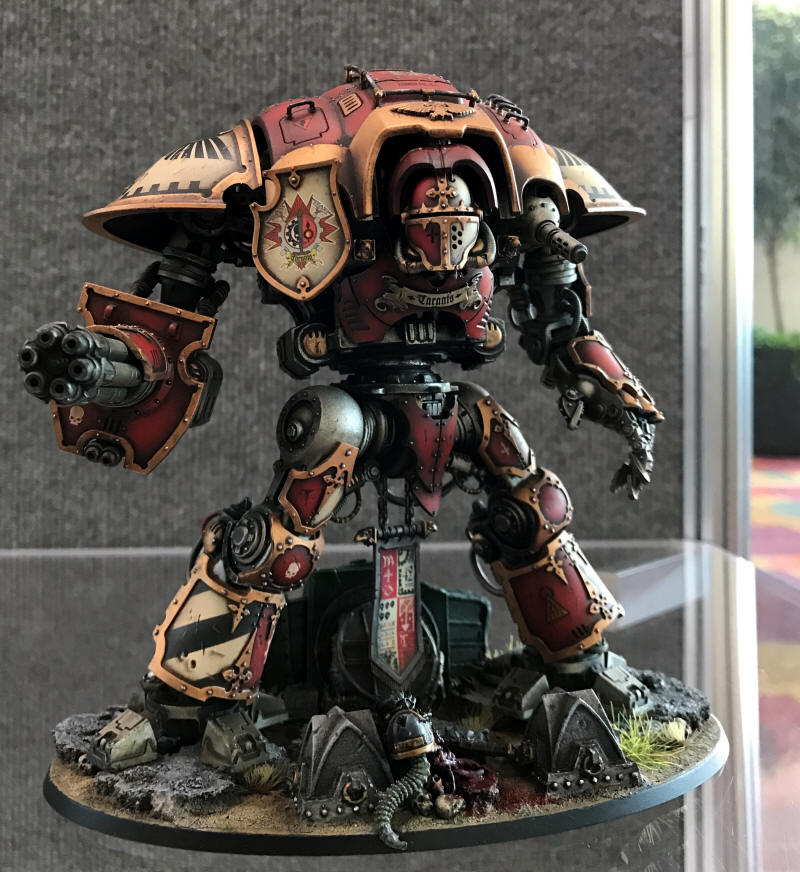Well, all the amusing Gencon stories obviously.

The big welcome sign at the Indianapolis Airport
We met Eric and his sons Ryan and Evan, Marty Connell (first timer), and Marty’s friend Steve there. Alison and I were at the Conrad, a nice boutique hotel with a spa (a couple’s massage has become of standard part of our Gencon experience) nestled between the Capital Grille, which had awesome breakfasts at outrageous prices, and “Tastings, A Wine Experience,” which had awesome wines at outrageous prices (the Capital Grille beat it all hollow with "the generous pour," a $28 per person tasting of seven wines where you could then have as much of anything you liked as you wanted... not that I signed up or anything... at least, not more than once).It is connected by a skywalk to the Circle Mall, which is connected to the World Master Garage (I am not making that up), which is connected to the convention center, so you never had to go outside if you didn’t want to.

 |
 |
The Stories
The stories started on arrival Wednesday evening. We reached the hotel a little before six, dropped luggage, headed for the convention center, and after getting our passes and event tickets, went looking for dinner. We randomly selected Ruth’s Chris Steak House. As we walked into the candlelit restaurant, dark mahogany wood panels and bar giving it an old world, classic vibe, I said “we should have a quiet dinner… this kind of place is not where the Gencon rank and file hang out.” And as our eyes adjusted to the dimly lit interior, saw the sea of grungy t-shirts, cargo shorts, neon colored sneakers, bushy beards and impressive girths we have come to associated with the Gencon gamer crowd. “Except for tonight” I finished. Weakly. We were shown to our table by a waiter who was trying not to sigh in relief that he had a couple of people that were dressed like they might leave a tip, and in the room we ended up in is table after table of Gencon gamers. Except at the table next to ours, which we passed going in. Sitting there was the typical bearded, overweight, black plastic rimmed glasses gamer, and sitting next to him was an elvish princess. I don’t mean in the cosplay sense, I mean she was petite, blond, had a long pony tail, high cheeks, slim legs, large breasts, and a little black dress meant to make her ample tracks of land available for all to worship. Like, gorgeous, “could have been the model for the everquest elvish princess” kind of elvish princess. And as we pass the table, she’s saying “Really, that’s so fascinating. Have you been doing this gaming thing very long?” As I sit down I lean over to Alison and she leans over to me and I say “Prostitute” exactly the same time she says “Escort.” And I say, “jinx, owe me a coke,” because really, same difference. I peeked but disappointingly his t-shirt was some generic dragon thing, not the “I save my money to go to Gencon, play games, and get laid” I was hoping for.
Which leads to the flip side story at the back end (don’t worry, there’s more in between); we were checking out, and heading down the hallway from our room with our luggage, when we ran into someone heading for the elevator at the same time. Alison and I are dressed casually, polo shirt and jeans for me, short sleeve shirt and slacks for Alison. He looked and said “You were here for the convention?” And Alison said “Yes.” And he said “Did you save up all your money for a year to come here?” And I said “This polo shirt is from our trip to France a month ago, and after that we did California, then Vancouver, and then New York City. No, we travel a lot, actually.” The guy looked shocked, and I think it’s funny that I was a little miffed that he would assume just because we like games and cosplay that we were low income losers, despite making the same assumption about the guy we saw the first night at Chris Ruth’s. So now I want his t-shirt to read “I’m independently wealthy, and I can do board games and hookers whenever I want to, so screw you” instead.
And here’s a proto Gencon story, or maybe a meta Gencon story. I commented to Alison that it would be interesting to have a dozen randomly selected people at Gencon tell their story. Really, you see things and you wonder. Most of the restaurants have tables of four to ten gamers. They are generally happy, laughing, sharing stories. There are the typical odd patterns, the hard edge of who likes who and “they did that to me” creating stress patterns that show up in odd ways, the kinds of things that happen with any large group. Why are those two people talking past the person sitting between them? Why in that group of seven men and one woman does she seem like the one no one wants to talk too? But you wonder… did they all come together? Did they rendezvous at Gencon, college buddies bound by games, with a yearly get together at the center of the gaming universe? Did they meet at the con and bond over this or that game? And in the convention center, you see the lonely ones, the ones that are sitting alone, looking unhappy, looking lost. And at the gaming tables… in “Terraforming Mars” there were a couple of guys, older gents that looked pretty much like me… that is, average older guys, a little overweight, a lot of hair loss, but on their own. “Hi, I’m Jim.” “Hi, I’m John.” That’s about all you know, other than they are there alone. Do they come by themselves? Do they have wives that are more into collectable card games so they split up until the gaming stops (except at Gencon, it never stops). Would I go to Gencon if I didn’t have friends there, if Alison didn’t go? Would that be the high point of my year? Why are we here? What is our purpose?
So, less philosophically, here is an in-between stories… I forgot my pass and event tickets in Boston. And my driver’s license in the photocopier, which fortunately Maddy found because she happened to need to photocopy something the day we were all flying out. So Alison had to hand me my license at the airport so I could actually board the plane. The pass and event tickets, as it turned out, could be reprinted at Gencon… for full cost, which seemed a bit harsh for a crowd that you have to assume are not in the “solve problems by throwing money at them” club, but it worked. But while we were standing in line, Alison heard this little tidbit, which was just so “Overheard at Gencon”:
Gamer 1: "I've never made a mistake in my life!"
Gamer 2: "Yes you have!"
Gamer 1: "Oh I meant TODAY. If you're talking about HISTORY,
well...."
Gamer 2 : "If you were Pinocchio your nose would have hit the WIll
Call Booth"
That may all seem a little inane, but then when we got back Alison forced me to watch some of "Bachelor in Paradise" with her (by asking me to watch it with her), and there the conversations was about how the girls were not trying to "slut-shame" each other. I like the Gencon version better. So, the games. Here are a few shots of our fantabulous game playing, along with some general Gencon shots, including the only computer gaming room with free access to games I've ever seen at a con that was almost completely empty:
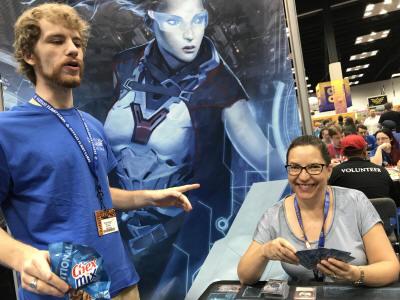 |
 |
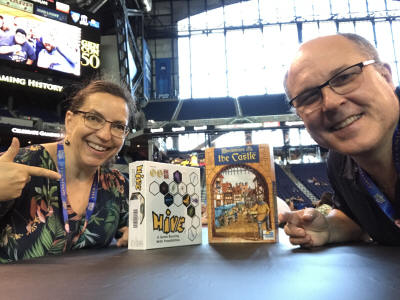 |
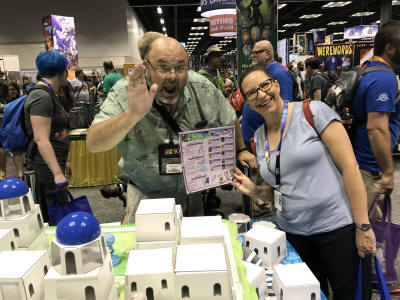 |

 |
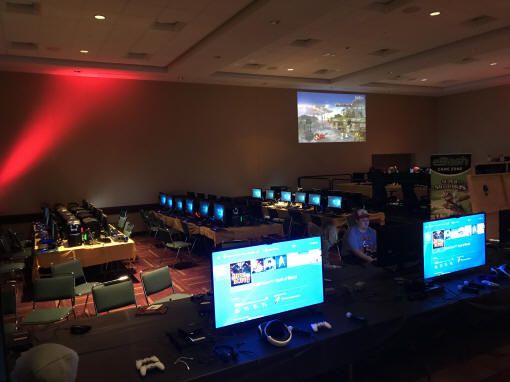 |
The Games
I’m going to start with a game I didn’t actually play at Gencon, but has a Gencon story behind it. For Gencon last year, we had four groups all signed up and all four of us were burned by the housing lottery, which made hotel rooms impossible to get anywhere within a 30 mile radius of Indianapolis. So we didn’t go last year, but I followed the buzz, and the top game at the end of the convention was something called “Scythe,” which looked cool. So I decided I’d just buy it blind. And found out it was sold out EVERYWHERE, could not find a copy on Amazon or any of the boardgame sites, with no date for when more copies might be available. Alison, in the meantime, was visiting Noah in NYC, and they stopped by a local game store, and she decided randomly to buy me a game, and the game store owner suggested this game… which was a bit pricy… that he had one copy left of. Scythe, of course. So, I’m going to include it here, mostly to compare it to two other games I did try at Gencon.
I should say what you like in games depends on what you like to play. For me, it is generally medium complexity games that you can explain the rules to others in half an hour and have a good sense of the game after one or two plays; that’s because it fits in with the gaming crowd I tend to play with and because my own time is limited… I cannot spend three or four hours gaming consistently, so things that you can finish in under two are a priority. Given that, here's the list of things I played at Gencon (+ Scythe) and my recommendation (buy or pass):
Scythe: Scythe is an alternate-history game with a steampunk backstory. It’s hard to pigeonhole in standard game type terms; it is part area control, part worker placement, part role selection, part miniatures (not in the classic sense, but in the “it has cool miniatures to presents mechs”). There are a few interesting variations on those themes; role selection is individual, that is, you select a role which is composed of a top and bottom action, but it only applies to you, and the only rule is that you have to select a different one next time, not that other players follow your choice. Worker placement is partly for area control, partly for resource production, and partly for “passive defense,” in that your opponent loses influence points for attacking regions with workers in them. And so on. The board is big, but the “areas” are large as well; this is a game where players typically move units one area at a time, so you can figure out who might attack you any particular turn. The major theme is engine building; almost every turn you’re looking for ways to improve some aspect of your faction, because the general idea is to collect six out of a dozen or so victory conditions, and you are trying to find ways to maximize your ability to get the six you decide to go after. I like Scythe; I’m trying to decide if I like it a lot (near the end, there are a lot of combinations that let you do tricky things to the point where it’s difficult to really figure out where you have risks and how to mitigate them… or maybe it’s because Noah stomped me horribly in the last two games at the end, hard to tell). It’s also bursty; you spend a lot of time getting your first three victory conditions, and then usually you can get the next three in two or three turns. It’s at the high end of complexity and time for me… it takes one and a half to two hours to play, and I feel like I have a good feel for it after two games. Recommendation: buy.
Blood Rage: I played Blood Rage with Eric and his sons. I already owned it because I had signed up for BoardGameGeek on facebook; a post that the “number 17 game on BGG was on sale at Amazon for the lowest price ever” popped up and I went ahead and bought it, but never had a chance to play. Like Scythe, it has miniatures, a big board with big areas, different paths to victory, thematic elements, plays in about two hours, and has a combination of game types (area control, card drafting and role selection mostly). Unlike Scythe, the variations, mostly in combat, are so wide that there’s no ability to statically assign risk factors, and combat drives the game. For instance, Scythe uses generic combat points you build up during the game along with cards; you can use one card per unit you attack with (the only reason to attack with more than one) and the combat points cap at seven. Cards are worth 2 to 5 points, and you know the distribution. Then it’s all about figuring out what your opponent is likely to spend, and part of that is figuring out what you think they think you are going to play… but you have a very good sense of what is likely. Blood Rage uses a set number of combat points per unit (typically 1 to 3), which you know ahead of time, plus a card. But there are very few cards, and they have text that does random things that make it impossible to figure out what is actually going to happen in combat. Like, one card that says to discard all cards and play new ones. But there’s a card that says to ignore all the text on all cards. Stuff like that. Then there’s racial customizations; Scythe, when you are building your engine, you’re doing it in a way that slightly improves your production of something and slightly decreases the cost of something, minor variations on standard play. Blood Rage has cards like, “you get a monster that goes into a space and destroys everything in it,” the nuke of Ragnarok. All in all, it seemed so random that at the end you felt like you could have played blind and done just as well. To be fair, we did the first round without card drafting and that was clearly a mistake (but the guys TEACHING the game suggested it), because some of the cards do complement each other. But… it’s long, complex, random, and generally frustrating to play. Recommendation: I have shrink-wrapped version I will sell you very cheaply.
Empires of the Void II: Last of the “Scythe like” games. This one was mostly role selection, the classic kind where everyone has to follow suit (although they can do a different action by spending command points, or use it to replenish money and command points, so it’s not locked in like Puerto Rico), and area control. One interesting aspect is that area control occurs on two levels, ownership, where you’ve conquered the NPC race in the space, and Influence, where you’re just nice to them and they help you out as a result; they both have subtle advantages. Like Scythe and Blood Rage, it’s a fixed map, but the NPC races have “events” that make they act in different ways that vary from game to game, so each game has some differences from prior games. The general problem with Empires of the Void was that everything did something different from everything else, there were a lot of options available, you picked up special units that modified combat (and there were like eight or ten of them, each doing something different), the NPC events did random things, you would get cards that did random things… nothing like the nuke of Ragnarok, but reasonably powerful… and the end result is just a lot of complexity and having to spend ten minutes figuring out what you wanted to do on your turn. We finished up in three hours, of which maybe 30 minutes was having the rules explained, and I think it could have gone a lot longer. It wasn’t as crazy-random as Blood Rage, but there was a lot “what the heck just happened?” each turn we played. I think you would have a good feel for all the special conditions/actions/events/races after a half dozen games… but I can’t imagine playing a half dozen three hour games in any reasonable time frame. Recommendation: buy if you have a lot of time to spend, otherwise pass.
Terraforming Mars: I really liked the design of this game, where you are one of X corporations that are trying to make Mars habitable (but don’t be fooled, this is not a co-op game, it’s trying to be the person who contributes the most to getting there). This is mostly a card drafting game, although it has a board and most of the cards are there to let you do one of three things (or sometimes two things), either capture territory, modify resource production, or modify one of the three conditions you are working on to make Mars habitable, temperature, oxygen, and water. The game looks like a resource collection game at first, but you quickly realize that everyone produces the same amounts until you get cards that modify what you produce, and then there’s frequently “decrease megacredit production by two, increase heat and power production by two” … generally moving in the positive direction but you have to make tradeoffs. It felt like a decent simulation of Mars colonization, production values where high (like on every game I played at Gencon), and I think you could learn to play it given time. The problem is purely complexity; the cards do many very different things, there are many ways to collect victory points besides the main driver (changing one of the three Martian terraforming criteria), and those are the real path to victory; everyone was within a couple of points of each other in pure terraforming points. There were a few things like “animals” and “microbiology” that had completely different scoring mechanisms, which everyone ignored because how the cards would actually win you points in these areas wasn’t clear. There were breakpoints in the three criteria that gave you other advantages, so there was some timing aspect to it. All in all, it seemed like a balanced game and had nice thematic elements, but it was just much too complicated for casual play. Recommendation: Like Empires of the Void, get it if you have the time to play a two to three hour game a half dozen times.
Sagrada: This was a pattern matching game, very pretty and the basic rules are simple. You have a five by four grid with slots into which you put dice. The dice are six-sided die in five different colors. Basic rule is you cannot put the same color next to each other, and you cannot put the same number of pips next to each other (you cannot put a “3” die next to a “3” die). Scoring is done based on random criteria selected at the beginning of the game, like the game we played, you scored 5 points for having a row with five colors, 6 points for having a row with no repeated number of pipes, and 2 points for every one-pip die next to a two-pip die. Adding to the complexity is that you start with a random card that slides under the grid and constrains what you can put on some of the spaces by color or by pips or both. Then you add that the cards have different difficulty levels, and for each level you get a coin (they were little glass tokens instead, but same idea) and you can spend those coins to use a power to do different things, like one was “pick up a die on your board and move it to another space, ignoring placement rules.” These powers cost more as they are used, so the first person to use one spends one coin, the second two, etc. You toss a number of dice equal to twice the number of players plus one, and you go around in a circle and draft dice and try to get everything to fit, using your coins as a free action on your turn. The most annoying problem with the game was that the dice were kind of small and people kept knocking other dice out of place. The game play problem was that, with the special powers, it just became impossible to figure out your best move without spending a lot more time than what seems like it should be a “light” game was worth. Recommendation: Pass.
Ethnos: This was my pick of Gencon, the sweet spot, a medium complexity strategy game that combined limited deck building with territory control. You collect cards from the discard pile or draw from the top of the deck to try to get combinations of the same color or the same race, hobbits, giants, centaurs, etc. At any point, you play your set and discard anything that doesn’t fit into the discard pile (for others to potentially pick up). Each race has a different action associated with it. Each color has a different territory associated with it. You put one card on top, and that is the race and color associated with the stack. Typically, the color allows you to add one influence in the associated territory, with the caveat that the stack has to be larger than the number you already have there… so you can play a “one” stack in a territory you have no influence in, a two stack for a one influence territory, etc. The race specials are very different; the “bird folk” let you place in any territory, the hobbits don’t let you place at all, the giants give you victory points, etc. You score in two ways; at the end of each of three rounds, you score points for territories you have influence in, with the winner taking the lion’s share, and by the size of the stacks you play, with a one stack worth 0, a two stack worth 1, a three stack worth 3, up to a six stack worth 15. You must play a stack if you hit ten cards. This all sounds a little complicated, but it’s ten minutes to explain and you’ve got it all locked in by the time the first round is over. Games are typically an hour. Exactly what I was looking for. Recommendation: Buy.
Android: Netrunner: Ok, if you are reading this, you’ve probably played netrunner already. But Alison and I were looking for good two player games, Netrunner was highly ranked, and a table was available in the dealer area. So we sat down and played through a very short game (because the cards were not shuffled well), but it was enough to get a sense of the game. I won’t go into detail since it’s an old game, but I will say for a hand-management styled card game, it was very thematic and I loved the asymmetrical aspects of it; the hacker and the corporation have such radically different play styles and objectives it’s amazing they made it work as a game. Recommendation: Buy.
Hellapagos: This was a surprisingly entertaining game that I don’t recommend buying. You are shipwrecked on an island, and you need to build a raft to escape, but you must also forage for food, water, and supplies to survive until you have a big enough raft to carry everyone. Simple enough co-op game, right? Except with larger groups, as it turns out, it is almost impossible to get a big enough raft and the supplies to escape. So there is a certain amount of getting “voted off the island,” which is a polite way of saying “picking who to kill off,” that the group has to do. The moral ambiguity of the situation leads to some funny decisions, like “I have the fishing rod and collect extra food, so I’m going to give ammunition to the guy with the gun so he can kill someone besides me.” The biggest design flaw in the game is that you draw from a bag of dice to determine the amount of fish you get if you scavenge for food… except instead of dice, they used balls. Which rolled off the table more than once. Otherwise, it was entertaining. Problem is I suspect it’s entertaining once or twice and then it would just be a pretty random game without many interesting decision points. Recommendation: Get your friend to buy it and play it once or twice with six people.
3 Secrets: Cool concept, and it might be fun for people that want to think really, really hard. Pick 1 card out of 50. One person is the detective who reads the “story” on the back of the card with three secrets. On the front of the card is a picture with three highlighted items. The other players try to guess the three secrets based on the picture by asking “yes/no” questions, with five minutes per secret. A souped-up 20 questions variant. Problem is that some of the secrets are very specific and seem impossible to get. So, we had an “easy” card that was about a boyfriend who killed his ex-fiancée. We determined he killed his ex-something, but then we were supposed to guess that she had subsequently engaged to someone else and that her killer was hoping to pin it on the new fiancée. Like, not happening. Recommendation: Pass. Lethal Party: This game was so bad I will not waste time describing it. Pass.
Santorini: Tic-tac-toe on steroids with random god powers thrown in. A pretty game, you move pieces around a board and can build structures in adjacent spaces to the piece; the structures can be built up to three levels high, one level at a time. When you move, you can move up one and only one level. The goal is to be the first to reach level three. But you can “cap” a three story structure, in which case it can’t be moved too. Each person has a god power; we didn’t do anything with them for the demo, but some of them are pretty amusing, like one makes you invisible, so the other player doesn’t know where your builder is and has to try to derive it from where you built structures. It’s cute, two player, Marty loves it, and it’s themed after my favorite Greek Island. Recommendation: Buy.
Carcassone The Castle: A two player variant of Carcassone that plays inside a prescribed and odd shaped frame. It was basically Carcassone with a track that rewarded scoring points early in the game. Good if you like Carcassone. Recommendation: Doesn’t matter, it’s out of print.
The Other Stuff
Ok, with that out of the way, we have the other things that are always pretty spectacular; miniatures and cosplay. Cosplay first! Below are of a few of the ones I liked (or, in the case of the Dalek baby carriage and the Ewok, where just too darned cute. We didn't make it to the cosplay parade this year, and while we did make it to the awards ceremony, it ran over and we had to depart before they did the post-award photos sessions. But just the ones wandering the halls were pretty amazing:
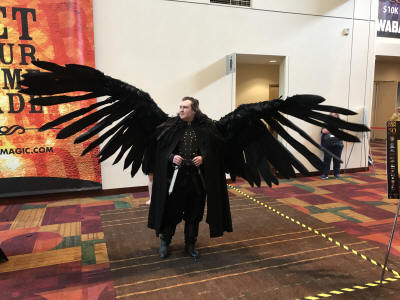 |
 |
 |
 |
 |
 |
 |
 |
 |
 |
And here are the miniatures, which never fail to amaze me in the details that are painted on these tiny little figures. Some of the larger ones can take upwards of three days to paint.
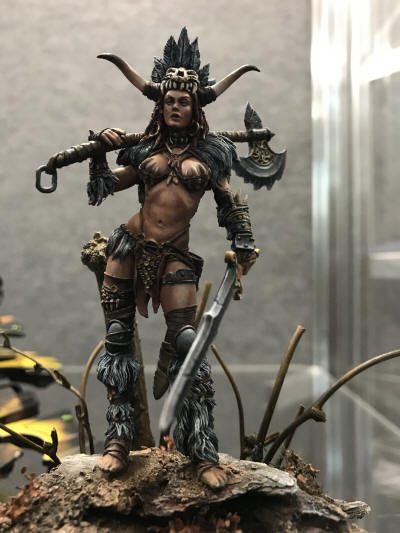 |
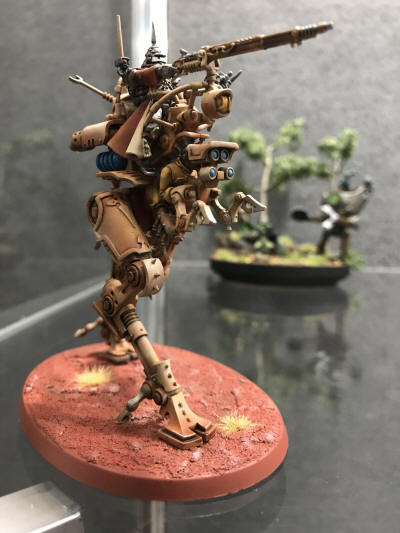 |
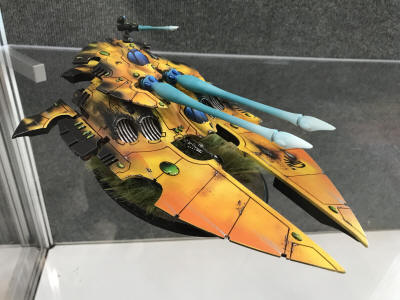 |
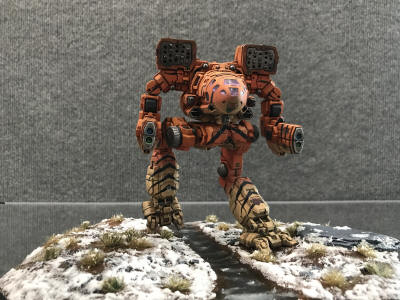 |
